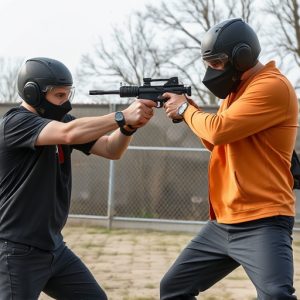Stun Weapon Range: Effective Defense for College Students?
Self-defense stun guns designed for college students provide a compact, portable option for personal…….
Self-defense stun guns designed for college students provide a compact, portable option for personal protection. Operating with high voltage, low-current electric shocks, these devices temporarily incapacitate attackers without permanent harm. Popular among students due to their concealability and varying projectile ranges (typically 2-3 meters), stun guns complement other safety measures like training and situational awareness. Legality varies by state and campus policy, requiring students to consult local laws and understand the device's limitations and responsible use. Comprehensive training ensures users can confidently and safely deploy these tools when needed.
“Uncover the surprising capabilities of stun weapons, especially their projectile range, in this comprehensive guide. As self-defense options gain popularity among college students, understanding how these devices work and their effective reach is paramount. We explore the technology behind stun weapon projections, their legal status on campuses, and essential safety training. Learn why stun guns could be a viable option for personal safety, offering a non-lethal deterrent at close to intermediate ranges.”
- Understanding Stun Weapon Technology: How Do They Work?
- Self-Defense Stun Guns: A College Student's Option?
- Projectile Range: The Effective Distance of Stun Weapons
- Legal Considerations for Carrying Stun Guns on Campus
- Safety and Training: Maximizing the Potential of Stun Weapons
Understanding Stun Weapon Technology: How Do They Work?
Stun weapons, also known as stun guns or electric tasers, are self-defense tools designed to incapacitate an opponent temporarily without causing permanent harm. The technology behind these devices has evolved significantly over the years. They function by delivering a powerful electrical current through two probes or electrodes into the target’s body, disrupting muscle control and causing intense pain and temporary paralysis.
These weapons operate on a simple principle: applying a high voltage, low-current electric shock to disrupt the nervous system. Modern stun guns for college students often feature compact designs, making them easy to carry and conceal. When activated, they emit an electrical discharge that can stop an attacker momentarily, providing users with time to escape or summon help. Understanding how stun weapon technology works is crucial for anyone considering it as a means of personal protection, especially in potentially dangerous environments like college campuses.
Self-Defense Stun Guns: A College Student's Option?
For college students looking into self-defense options, the concept of stun weapons as a viable solution is gaining traction. Self-defense stun guns offer an alternative to traditional firearms, appealing to those who prioritize non-lethal force for personal safety on campus. These compact devices can fit easily in a backpack or purse, providing a sense of security in an unpredictable environment. With varying projectile ranges, students can choose options tailored to their specific needs and comfort levels.
Considerations for college students include training and familiarity with the device, as well as understanding local laws regarding stun weapon possession. While stun guns may not replace other safety measures, they could serve as a crucial tool in personal defense scenarios, empowering students to protect themselves during emergencies or potential assaults.
Projectile Range: The Effective Distance of Stun Weapons
Stun weapons, often carried as self-defense tools by college students and others, have varying projectile range capabilities. Typically, stun guns or tasers can effectively stun a target within 2-3 meters (6-10 feet) in ideal conditions. However, factors like the user’s skill, environmental obstacles, and the weapon’s design can impact this distance. For instance, some advanced models designed for military or law enforcement use may offer a slightly longer range of up to 5-7 meters (16-23 feet), but these are less common in civilian-grade self-defense stun guns.
Understanding the effective range is crucial when considering self-defense stun guns for college students. It’s important to note that while these weapons can provide a non-lethal means of incapacitating an assailant, their range limitations mean they are best suited for close encounters. Training and familiarization with the weapon’s functionality and range are essential to ensure safe and effective use in real-life situations.
Legal Considerations for Carrying Stun Guns on Campus
The legality of carrying self-defense stun guns on college campuses varies significantly from state to state, reflecting complex legal considerations. Many institutions strictly prohibit the possession of any type of firearm, including stun guns, within campus boundaries. This restriction stems from the need to maintain safe and weapon-free environments for students, faculty, and visitors. However, some states allow individuals to carry stun guns with a permit or under specific circumstances, such as in their vehicles or while on public property outside of school grounds.
College students considering self-defense options with stun guns must navigate these legal complexities. Understanding state and campus policies is crucial before making the decision to purchase and carry a stun gun. Students should consult local laws, reach out to campus security or administration, and explore alternative self-defense strategies such as situational awareness, personal safety apps, and emergency notification systems already in place on many campuses.
Safety and Training: Maximizing the Potential of Stun Weapons
Stun weapons, especially self-defense stun guns designed for college students, offer a unique blend of power and portability. However, their effective use hinges on rigorous safety training. Without proper instruction, users risk not only ineffective deployment but also potential harm to themselves or bystanders. Many modern stun devices come with integrated safety mechanisms, such as trigger lock features, to prevent accidental activation.
Training should cover not just the technical aspects of weapon use but also scenario-based practice. This includes learning appropriate self-defense strategies, understanding the legal implications of using a stun gun in different jurisdictions, and practicing responsible handling and storage. Proper training empowers users to maximize the potential of their stun weapons while ensuring safety remains paramount.
Stun weapons, particularly in their projectile form, offer a unique self-defense option for college students seeking to protect themselves on campus. With a range that can vary from 10 to 50 feet depending on the device, these non-lethal weapons provide a tactical advantage in close-quarters situations. However, it’s crucial for users to prioritize safety and training, understand local laws regarding stun gun possession, and recognize their limitations. By doing so, college students can make informed decisions about employing self-defense stun guns as a last resort while navigating the challenges of urban environments.


